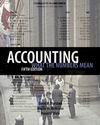 |  Accounting: What the Numbers Mean, 5/e David H. Marshall,
Millikin University
Wayne W. McManus,
International College of the Cayman Islands
Daniel F. Viele,
Webster University
Cost Analysis for Decision Making
Chapter 16 Learning ObjectivesAfter studying this chapter, you should understand:
1.The meaning and application of the following cost terms: differential, allocated, sunk, and opportunity. |
 |  |  | 2.How costs are determined to be relevant for short-run decisions. |
 |  |  | 3.The special pricing decision when a firm is operating at full rather than idle capacity. |
 |  |  | 4.The attributes of capital budgeting that make it a significantly different activity from operational budgeting. |
 |  |  | 5.Why present value analysis is appropriate in capital budgeting. |
 |  |  | 6.The concept of the cost of capital and why it is used in capital budgeting. |
 |  |  | 7.The use of and differences between various capital budgeting techniques: net present value, present value ratio, and internal rate of return. |
 |  |  | 8.How issues concerning estimates, income taxes, and the timing of cash flows and investments are treated in the capital budgeting process. |
 |  |  | 9.How the payback period of a capital expenditure project is calculated. |
 |  |  | 10.Why the accounting rate of return of a project is calculated and how it can be used most appropriately. |
 |  |  | 11.Why not all management decisions are made strictly on the basis of quantitative analysis techniques. |
|


 2002 McGraw-Hill Higher Education
2002 McGraw-Hill Higher Education